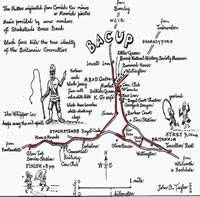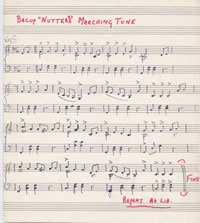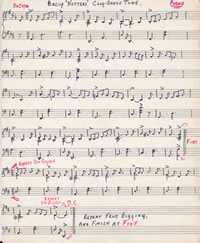Local traditions - the Nutters
10/05/14 21:22
Janet Few recently blogged (April 16th) on the importance of remembering and describing local customs and their importance to your one-place study. I don’t think there are any which are specific to the Springhill area or even Higher Cloughfold but there are a few of interest which are only slightly further afield.
Of these perhaps the best known is the Britannia Coconutters, a morris dance troupe which date over 150 years. Their Easter dance starts at the Travellers’ Rest in Whitworth at 9 am on Easter Saturday and dances through the streets of Bacup to the far boundary at Stacksteads, traditionally calling at every licensed premises on the way. Hic. The route is shown in the map below by the local historian the late John B Taylor whose work has contributed greatly to this study in many ways. Sadly, the route doesn’t pass through Higher Cloughfold.
They dance in blackup and have done so throughout their history. This may be a reflection of their supposed mining origins or so that the spirits don’t recognise the dancers. From time to time some try and attach less pleasant motives to the use of blackup; an interesting discussion between the secretary of the Nutters and a representative from the Society of Black Lawyers on the Radio 4 PM programme recently led to the latter declaring that they had no problem with it. Another threat comes from the lack of public sector funding which has led to the authorities threatening to withdraw support to marshall the route. This is an ongoing issue and the future of the Easter Saturday dance is somewhat precarious.
They perform five garland dances performed in square set and two nut dances performed in line. An example of their dancing is seen in this video. I was fortunate enough to have been given copies of the music used for marching and one of their dances; these are also below. Clicking on the image will lead to larger copies.



This extract of the history is from the Nutter’s own site:
“The picture is by no means clear and tales have been related by word of mouth, however the dances are supposed to have originated with moorish pirates (hence the costume). Some of these sailors are said to have settled in Cornwall and become employed in local mining. As mines and quarries opened in Lancashire in the 18th and 19th century a few Cornishmen came North bringing with them mining expertise. It is with these people that the dances were reputedly bought to this area, in particular two Cornishmen who came to work in Whitworth (this was related by a former team member many years ago). The Dances spread throughout Rossendale and around the turn of the Century there were at least four troupes. One of these was the Tunstead Mill Troupe who celebrated their half century in 1907. It is from this troupe that Britannia is descended.”
Of these perhaps the best known is the Britannia Coconutters, a morris dance troupe which date over 150 years. Their Easter dance starts at the Travellers’ Rest in Whitworth at 9 am on Easter Saturday and dances through the streets of Bacup to the far boundary at Stacksteads, traditionally calling at every licensed premises on the way. Hic. The route is shown in the map below by the local historian the late John B Taylor whose work has contributed greatly to this study in many ways. Sadly, the route doesn’t pass through Higher Cloughfold.
They dance in blackup and have done so throughout their history. This may be a reflection of their supposed mining origins or so that the spirits don’t recognise the dancers. From time to time some try and attach less pleasant motives to the use of blackup; an interesting discussion between the secretary of the Nutters and a representative from the Society of Black Lawyers on the Radio 4 PM programme recently led to the latter declaring that they had no problem with it. Another threat comes from the lack of public sector funding which has led to the authorities threatening to withdraw support to marshall the route. This is an ongoing issue and the future of the Easter Saturday dance is somewhat precarious.
They perform five garland dances performed in square set and two nut dances performed in line. An example of their dancing is seen in this video. I was fortunate enough to have been given copies of the music used for marching and one of their dances; these are also below. Clicking on the image will lead to larger copies.



This extract of the history is from the Nutter’s own site:
“The picture is by no means clear and tales have been related by word of mouth, however the dances are supposed to have originated with moorish pirates (hence the costume). Some of these sailors are said to have settled in Cornwall and become employed in local mining. As mines and quarries opened in Lancashire in the 18th and 19th century a few Cornishmen came North bringing with them mining expertise. It is with these people that the dances were reputedly bought to this area, in particular two Cornishmen who came to work in Whitworth (this was related by a former team member many years ago). The Dances spread throughout Rossendale and around the turn of the Century there were at least four troupes. One of these was the Tunstead Mill Troupe who celebrated their half century in 1907. It is from this troupe that Britannia is descended.”




